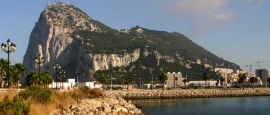Gibraltar's interesting architecture includes the 14th-century keep of the much-rebuilt Moorish Castle; the Shrine of Our Lady of Europe, a mosque before its conversion to a Christian chapel in 1462, which houses the 15th-century image of the Patroness of Gibraltar; and the Lighthouse and Mosque, which blends classic Islamic design with modern facilities.
Gibraltar things to see and do
Tourist offices
Address: Gibraltar House, 150 Strand, London, WC2R 1JA, United Kingdom
www.visitgibraltar.gi
Located inside the Rock, St Michael's Cave is situated 300m (1,000ft) above sea level, and was known to the Romans for its spectacular stalactites and stalagmites. It is part of a complex series of interlinked caves, including Leonora's Cave and Lower St Michael's Cave. Today, it is used for concerts and ballet. The Upper Galleries, hewn by hand from the Rock in 1782, house old cannons and tableaux evoking the Great Siege (1779-1783).
See a replica of the Gibraltar Skull – the first Neanderthal skull found in Europe (1848) – and caveman tools and ornaments excavated from the Rock's caves. There are also exhibits from the Phoenician, Greek, Roman, Moorish, Spanish and British periods of the Rock's history, a comprehensive collection of prints and lithographs, and a large-scale model of the Rock made in 1865.
Head to the Convent at the end of Main Street to see the daily changing of the guards. The convent has been the residence of the governor since 1728, and was formerly a 16th-century Franciscan Monastic house. It is also rumoured that the convent is haunted by the ghost of a nun, known as the 'Lady in Grey'.
Birdwatching can be undertaken in spring and autumn, when thousands of migrating birds stop off on their way between their breeding grounds in northern Europe and their wintering areas in Africa. Owls, eagles, harriers, hoopoes, buzzards and black kites join resident species such as peregrine falcons, blue rock thrush and Barbary partridge.
Gibraltar has some great beaches to explore. On the east side of the island are Eastern Beach and Catalan Bay. Little Bay, a pebble beach, and Camp Bay/Keys Promenade are on the western coast. Pier fishing facilities are available on the island and scuba-diving, parasailing and water-skiing can also be practised.
In the Apes' Den, take pictures of the famous Barbary apes, which are in fact not apes but macaque monkeys without tails. These are the only wild primates in Europe. The Spanish once said that when the monkeys left Gibraltar, the British would follow. This prompted the British PM to have more apes delivered to the Rock.
Go on a guided walking tour around the city walls, held every Friday at 1030. The walls and fortifications of the City of Gibraltar were first built by the Moors to defend the country against invasion, and have since been added to by the Spanish and British. A walk along the walls is the best way to get a glimpse into the history of the city and sites.
Find the town's ancient cemetery just off Main Street, at Southport Gate. Treacherous sea battles took their toll, with many lost lives commemorated here. Browse the intricate and well-kept headstones, some dating back to 1789.
Take a cable car trip to the top of the Rock. Built in 1966, the Top Station is on the summit of the Rock, from where visitors can see Spain to the north and Africa to the south. The cable car journey stops at the Apes' Den, where the islands' famous primates scamper about.
The Bay of Gibraltar is home to a large population of dolphins and whales, and tourists can take boat trips to view these fascinating creatures. It’s easy to spot the dolphins (some operators offer guarantees), but the whales – including killer, fin and humpbacks – are a little more aloof.
Do you have any Feedback about this page?
© 2026 Columbus Travel Media Ltd. All rights reserved. No part of this site may be reproduced without our written permission, click here for information on Columbus Content Solutions.








 You know where
You know where